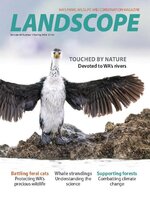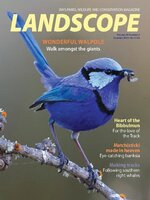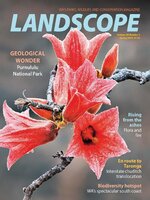Stories of the triumphs of science and the wonder of Western Australia's natural places, told by those on the ground and celebrated with visually stunning photography.
On the cover
From the desk of Parul Chauhan
Contributing
LANDSCOPE Magazine
Reader’s pic • Euro (Osphranter robustus)
Community-built quenda habitats at Helena River
Makeover for Torndirrup National Park
Monitoring species at the Houtman Abrolhos
New boardwalk at Mangrove Cove
Guest column
Mount Frankland National Park • Mount Frankland National Park is located 28 kilometres north-east of Walpole in Australia’s south-west. The park covers 31,000 hectares of tingle, jarrah and karri forest as well as the impressive Mount Frankland Wilderness Lookout.
Play Trails
Emergency WA
Australian Native Plants – 7th edition
More than 5 million reasons to celebrate WA parks • In 2019, an ambitious target was set. Five million hectares of new conservation areas would be created across Western Australia—with the support of Traditional Owners—to enable the potential of a truly significant conservation outcome.
Parrots out of place • While human impacts have changed the landscape in some parts of Western Australia, population numbers of the iconic pink and grey galah (Eolophus roseicapilla) seem to be benefitting from the changes.
Oh what a tangled wattle we weave • Once thought to be extinct, this wiry entangled shrub certainly lives up to its name—tangle wattle (Acacia volubilis)—with volubilis, meaning twining, in reference to the twisted, tangled and twining habit of the plant. Scientists are taking a closer look at the species that is only found in a small area in the Wheatbelt.
Wild wonders of Western Australia • The incredible beauty of Western Australia’s natural areas has been captured in high resolution with more than 980 entries as part of the WA Parks Foundation’s Wild Wonders of Western Australia photo competition.
Grevillea kulikup
Beyond bee hotels • Expanding bee-friendly gardens to include ground-nesters
Navigating the waters of visitor monitoring in marine areas • The beauty of Western Australia’s marine areas cannot be understated. The tropical waters in the north to the cool, clear waters of the south-west are bursting with biodiversity that draws visitors from around the world. Establishing how many people visit WA’s marine areas, as well as what activities these visitors get up to, requires a combination of people power and technological solutions.
Pink cockatoos and solitude • After taking up the hobby of nature photography during the COVID-19 pandemic, amateur birder Beverley Oliver braved the rugged roads near Cocklebiddy to participate in a unique photography course at the famous Eyre Bird Observatory.
Marvellous marsupials • Australia is home to more than two thirds of the world’s marsupials, but what is a marsupial? Marsupials are mammals that have a pouch to carry their young, called joeys. Joeys are born small, underdeveloped and would not survive in the outside world. Kangaroos for example are born the size of a jellybean and live in their mother’s pouch for eight months before emerging.
Blue-banded bees

 Volume 40, Number 3
Volume 40, Number 3
 Volume 40, Number 2
Volume 40, Number 2
 Volume 40, Number 1
Volume 40, Number 1
 Volume 39, Number 4
Volume 39, Number 4
 Volume 39, Number 3
Volume 39, Number 3
 Volume 39, Number 2
Volume 39, Number 2
 Volume 39, Number 1
Volume 39, Number 1
 Volume 38, Number 4
Volume 38, Number 4